Themed collection Molecule-based surface chemistry

Single-molecule chemistry and physics explored by low-temperature scanning probe microscopy
Recent developments in scanning probe microscopies (STM and AFM) have made it possible to study chemistry and physics at the single molecule level.
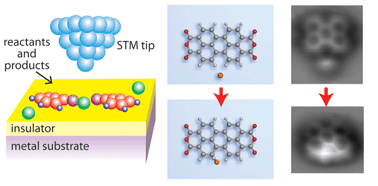
Chem. Commun., 2011,47, 9011-9023
https://doi.org/10.1039/C1CC11404B
Varying molecular interactions by coverage in supramolecular surface chemistry
A combination of STM, XPS and DFT calculations shows the possibility of modifying intermolecular interactions of absorbed benzene-carboxylic acids from coordination to H-bonding by changing the surface coverage.
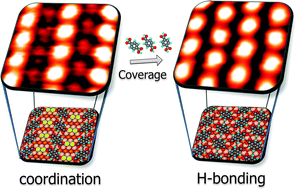
Chem. Commun., 2012,48, 534-536
https://doi.org/10.1039/C1CC14497A
Synthesis of two-dimensional phenylene –boroxine networks through in vacuo condensation and on-surface radical addition
A doubly functionalized monomer is used to synthesize covalent phenylene–boroxine hybrid-networks by condensation in the crucible and radical addition on a Ag(111) surface.

Chem. Commun., 2011,47, 12355-12357
https://doi.org/10.1039/C1CC13896K
Stereo-isomerism controls surface reactivity: 1-chloropentane-pairs on Si(100)-2×1
Chloropentane forms symmetric (S) and asymmetric (A) pairs on Si(100)-2×1, differing in the direction of curvature of one pentane tail of the pair. This renders the rate of thermal chlorination reaction fifteen times slower for ‘S’ than for ‘A’, at room temperature.
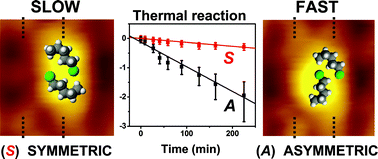
Chem. Commun., 2011,47, 12101-12103
https://doi.org/10.1039/C1CC14117A
Formation of a non-crystalline bimolecular porous network at a liquid/solid interface
An equimolar mixture of two structurally related molecules self-assembles into a 2D non-crystalline bimolecular porous pattern at a liquid–solid interface.
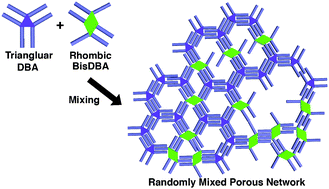
Chem. Commun., 2011,47, 11459-11461
https://doi.org/10.1039/C1CC14362J
Conglomerate with periodic enantiomer inclusion: A mechanism for homochirality erosion
An achiral molecule forms one-dimensionally periodic patterns through enantiomeric aggregate inclusion.

Chem. Commun., 2011,47, 11432-11434
https://doi.org/10.1039/C1CC12317C
Post-synthetic modification of epitaxially grown, highly oriented functionalized MOF thin films
The properties of thin, highly porous MOF coatings can be tailored by post-synthesis modification (PSM). To this end, different functionalities are covalently attached to the inside of the MOF framework pores.
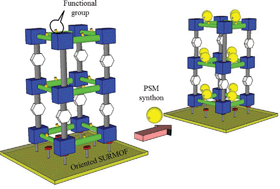
Chem. Commun., 2011,47, 11210-11212
https://doi.org/10.1039/C1CC12543E
Charge-assisted hydrogen bond-directed self-assembly of an amphiphilic zwitterionic quinonemonoimine at the liquid–solid interface
The self-assembly of a zwitterionic quinonemonoimine is driven by charge-assisted hydrogen bonding and reveals intriguing morphology, stereochemistry and multilayer formation.
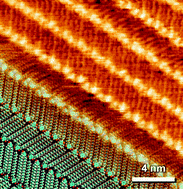
Chem. Commun., 2011,47, 11255-11257
https://doi.org/10.1039/C1CC14085J
Scanning tunneling microscopy /spectroscopy on self-assembly of a glycine /Cu(111) nanocavity array
Step-by-step analysis demonstrates the role of footprint chirality in glycine/Cu hierarchical self-assembly. Formation of quantum corral and manipulation of isolated C60 show the potential of this system for future applications.
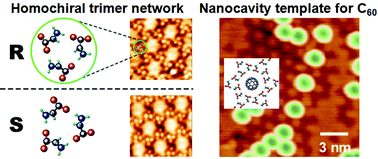
Chem. Commun., 2011,47, 11312-11314
https://doi.org/10.1039/C1CC11829C
Dynamic chiral flipping within strongly chemisorbed molecular monolayers at surfaces
Molecules within strongly chemisorbed homochiral monolayers can dynamically switch their chiral configurations and locally break enantiopurity.
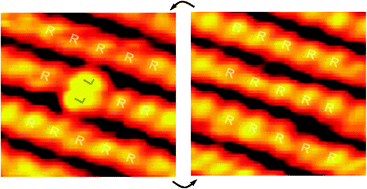
Chem. Commun., 2011,47, 11324-11326
https://doi.org/10.1039/C1CC13317A
Assessing the role of chirality in the formation of rosette-like supramolecular assemblies on surfaces
Molecular modelling simulations are used to unravel the origin of supramolecular chirality in rosette-like assemblies of conjugated oligomers.
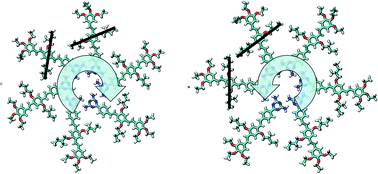
Chem. Commun., 2011,47, 10924-10926
https://doi.org/10.1039/C1CC13250D
Highly sensitive electrical detection of TCNE on chemically passivated silicon-on-insulator
TCNE acts as an electron acceptor on silicon surfaces, leading to large reversible modulation of the drain current on alkyl passivated SOI pseudo-MOSFETS.
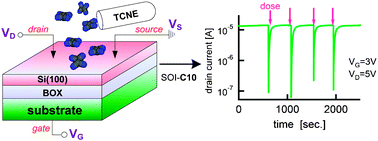
Chem. Commun., 2011,47, 10593-10595
https://doi.org/10.1039/C1CC12504D
Patterning small-molecule biocapture surfaces: microcontact insertion printing vs.photolithography
Small-molecule-based capture surfaces prepared by microcontact insertion printing vs.photolithographically assisted chemical patterning are compared. Selective capture of large-molecule binding partners from heterogeneous solutions is demonstrated.
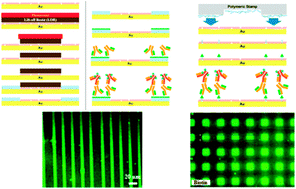
Chem. Commun., 2011,47, 10641-10643
https://doi.org/10.1039/C1CC13002A
Determination of relative binding affinities of labeling molecules with amino acids by using scanning tunneling microscopy
The binding behaviour of PcCu(SO3Na)4 on the peptide assemblies reveals its relative binding affinities with different amino acid residues.

Chem. Commun., 2011,47, 10638-10640
https://doi.org/10.1039/C1CC12380G
Retracted Article: Measuring Si–C60 chemical forces via single molecule spectroscopy
The interaction force and binding energy between a silicon cluster and a C60 molecule has been measured using atomic force microscopy.
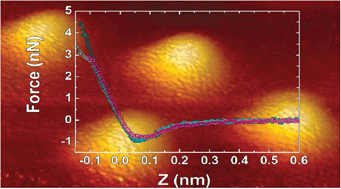
Chem. Commun., 2011,47, 10575-10577
https://doi.org/10.1039/C1CC14147C
Modulating the self-assembly of rigid “clicked” dendrimers at the solid–liquid interface by tuning non-covalent interactions between side groups
A matter of substitution: first generation poly(triazole-phenylene) dendrimers equipped with peripheral alkyl or carboxylic acid groups assemble into distinct two-dimensional nano-structures on graphite surfaces as revealed by STM investigations at the liquid–solid interface.
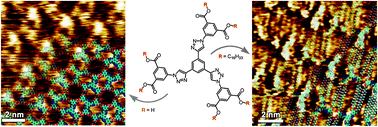
Chem. Commun., 2011,47, 10578-10580
https://doi.org/10.1039/C1CC13099D
[60]Fullerene-based monolayers as neuroprotective biocompatible hybrid materials
[60]Fullerene-containing SAMs on Au(111) surfaces are bioactive materials displaying a neuroprotective effect against L-Glu-induced excitotoxicity on human-derived undifferentiated neuroblastoma cells.
![Graphical abstract: [60]Fullerene-based monolayers as neuroprotective biocompatible hybrid materials](/en/Image/Get?imageInfo.ImageType=GA&imageInfo.ImageIdentifier.ManuscriptID=C1CC13971A&imageInfo.ImageIdentifier.Year=2011)
Chem. Commun., 2011,47, 10617-10619
https://doi.org/10.1039/C1CC13971A
Surface-supported 2D heterotriangulene polymers
Depending on activation temperature, assembly of tribromo-substituted heterotriangulenes on Ag(111) results in two-dimensional porous metal-coordination or covalent networks.
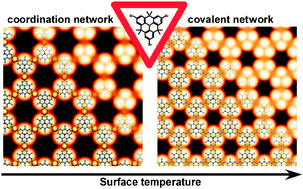
Chem. Commun., 2011,47, 10239-10241
https://doi.org/10.1039/C1CC12490K
(S)-Lysine adsorption induces the formation of gold nanofingers on Au{111}
Adsorption of (S)-lysine on Au{111} induces the formation of chiral Au nanofingers whose growth directions correlate with the preferred alignment of H-bonded lysine dimers observed in 2-D arrays.
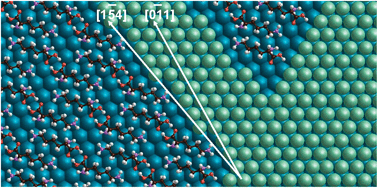
Chem. Commun., 2011,47, 10365-10367
https://doi.org/10.1039/C1CC13257A
Steering molecular island morphology on an insulator surface by exploiting sequential deposition
Island morphologies are steered by changing the deposition order in molecular coadsorption, demonstrating the decisive role of non-equilibrium processes in molecular structure formation on an insulating surface.
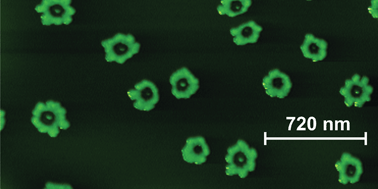
Chem. Commun., 2011,47, 10386-10388
https://doi.org/10.1039/C1CC12996A
Real-space observation of local anisotropic correlation between buckled dimers on Si(100) induced by a bidentate adsorbed molecule
Antiferromagnetic correlation between buckled dimers locally induced by chemisorption of a bidentate molecule on Si(100)(2 × 1) at 300 K.

Chem. Commun., 2011,47, 10392-10394
https://doi.org/10.1039/C1CC13822G
Locking the free-rotation of a prochiral star-shaped guest molecule inside a two-dimensional nanoporous network by introduction of chlorine atoms
STM reveals that replacing H-atoms by Cl-atoms in the prochiral structure of triazatrinaphthylene results in locking the free-rotation of the central guest molecules in the nanopores of the 2D lattice.
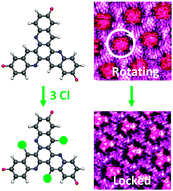
Chem. Commun., 2011,47, 10091-10093
https://doi.org/10.1039/C1CC12951A
Selective supramolecular assembly of multifunctional ligands on a Cu(111) surface: metallacycles, propeller trimers and linear chains
Three distinctive supramolecular structures, metallacycles, propeller trimers and extended linear chains, are selectively formed owing to different inter-molecular interactions.

Chem. Commun., 2011,47, 10073-10075
https://doi.org/10.1039/C1CC12294K
Single-layer graphene oxide sheet: a novel substrate for dip-pen nanolithography
CoCl2 is patterned on both single-layer graphene oxide sheets and SiO2 substrates simultaneously by dip-pen nanolithography, which is used for growth of different structured carbon nanotubes.
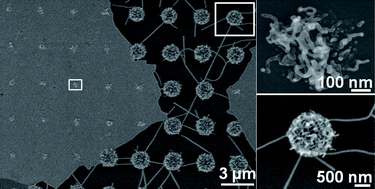
Chem. Commun., 2011,47, 10070-10072
https://doi.org/10.1039/C1CC12648B
Electrochemical scanning tunnelling spectroscopy of a ferrocene -modified n-Si(111)-surface: electrolyte gating and ambipolar FET behaviour
In situ scanning tunnelling spectroscopy reveals that ferrocene-modified n-Si(111) substrates show ambipolar FET behaviour if an electrolyte is used as a gate.
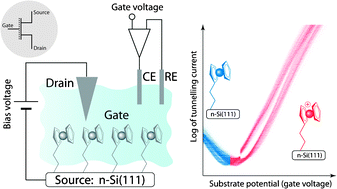
Chem. Commun., 2011,47, 9807-9809
https://doi.org/10.1039/C1CC13188E
Little exchange at the liquid/solid interface: defect-mediated equilibration of physisorbed porphyrin monolayers
Physisorbed porphyrins at a liquid/solid interface require specific defects to exchange with the supernatant.

Chem. Commun., 2011,47, 9666-9668
https://doi.org/10.1039/C1CC12569A
Halogen bonds as stabilizing interactions in a chiral self-assembled molecular monolayer
We present an STM study and DFT analysis of supramolecular networks formed by tetrabromotetrathienoanthracene at the liquid/solid interface.
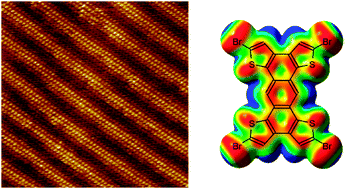
Chem. Commun., 2011,47, 9453-9455
https://doi.org/10.1039/C1CC13114A
Peculiar adsorbed phase behaviour of binary mixtures of oligopyridines and extension to a ternary mixture in a host–guest system
The composition of two- and three-component phase-separated adlayers is controlled by the absolute concentration in solution.

Chem. Commun., 2011,47, 9366-9368
https://doi.org/10.1039/C1CC13526K
On the transfer of cooperative self-assembled π-conjugated fibrils to a gold substrate
The transfer of the cooperative self-assembled fibrils to a gold substrate reveals the crucial role of the early formation of a monolayer.
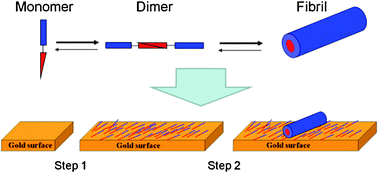
Chem. Commun., 2011,47, 9333-9335
https://doi.org/10.1039/C1CC12799C
Building layer-by-layer 3D supramolecular nanostructures at the terephthalic acid/stearic acid interface
Three dimensional (3D) supramolecular nanostructures were built up using terephthalic acid (TPA) and stearic acid (STA) molecules by layer-by-layer method, which can be utilized to fabricate novel 3D functional nanostructures.
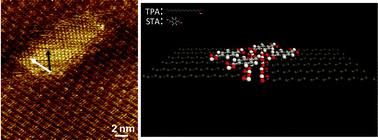
Chem. Commun., 2011,47, 9155-9157
https://doi.org/10.1039/C1CC11443C
Assembly of 2D ionic layers by reaction of alkali halides with the organic electrophile 7,7,8,8-tetracyano-p-quinodimethane (TCNQ)
Sublimation of NaCl onto a hydrogen bonded layer of TCNQ leads to formation of an ionic layer via charge-transfer reaction.
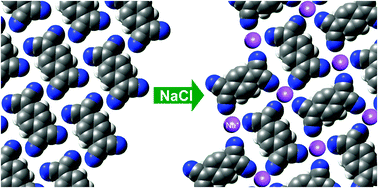
Chem. Commun., 2011,47, 9146-9148
https://doi.org/10.1039/C1CC12519B
Weak interactions in the assembly of strongly chemisorbed molecules
Room temperature bimolecular substituted aromatic-ketone complexes are formed on Pt(111) through CH⋯O interactions directed by partial dehydrogenation of the alkyl substituent.
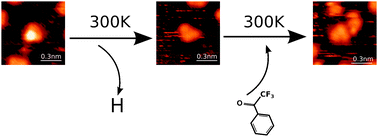
Chem. Commun., 2011,47, 9113-9115
https://doi.org/10.1039/C1CC12538A
Molecular packing density of a self-assembled monolayer formed from N-(2-aminoethyl)-3-aminopropyltriethoxysilane by a vapor phase process
The density of an AEAPS-SAM has been estimated to be about 3 molecules per nm2 based on chemical labeling with TNBS, optical absorption spectroscopy and X-ray photoelectron spectroscopy.
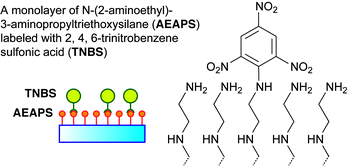
Chem. Commun., 2011,47, 8841-8843
https://doi.org/10.1039/C1CC12541A
Adlayers based on molecular platforms of trioxatriangulenium
Derivatives of the trioxatriangulenium ion were employed to prepare highly-ordered functional adlayers on Au(111) surfaces.

Chem. Commun., 2011,47, 8880-8882
https://doi.org/10.1039/C1CC12598B
Dual functions of a novel low-gap polymer for near infra-red photovoltaics and light-emitting diodes
We report synthesis of a new low-gap polymer and its applications both in photovoltaics and near-infrared light-emitting diodes.
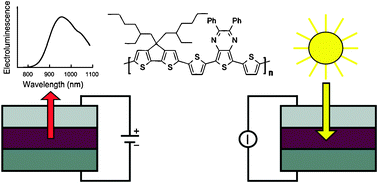
Chem. Commun., 2011,47, 8820-8822
https://doi.org/10.1039/C1CC12752G
Morphological and mechanical properties of alkanethiol self-assembled monolayers investigated via bimodal atomic force microscopy
Alkanethiol SAMs were investigated by means of BiModal AFM. Morphological and mechanical properties show a parabolic trend vs. the chain length n, ascribed to the disorder at the SAMs/Au interface.

Chem. Commun., 2011,47, 8823-8825
https://doi.org/10.1039/C1CC12567B
Self-assembled monolayers of clamped oligo(phenylene-ethynylene-butadiynylene)s
The monolayer packing behavior of rigid rods, clamped rigid rods, and macrocycles thereof is compared.
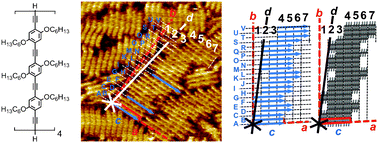
Chem. Commun., 2011,47, 8838-8840
https://doi.org/10.1039/C1CC12435H
Tetris in monolayers: patterned self-assembly using side chain shape
The packing and stability of monolayers depends on molecular shape. Anthracenes bearing complementary shaped alkadiyne side chains direct assembly of compositionally patterned, two component monolayers on HOPG.
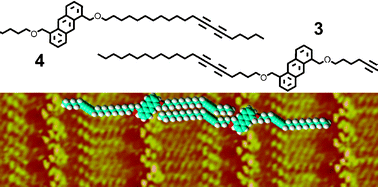
Chem. Commun., 2011,47, 8832-8834
https://doi.org/10.1039/C1CC12498F
Templated assembling of phthalocyanine arrays along a polymer chain
Copper phthalocyanine can assemble along PPE backbones into molecular arrays and 2D assemblies with structural parameters different from its intrinsic 2D crystal. The template effect depends on the match between the size of phthalocyanine and the repeating period of the PPE backbone.

Chem. Commun., 2011,47, 8829-8831
https://doi.org/10.1039/C1CC12468D
Anchoring of self-assembled monolayers of unsymmetrically-substituted chromophores with an oxoporphyrinogen surface clamp
N-substituted oxoporphyrinogens land with N-substituents up when deposited on Au(111) yielding an effective method for surface functionalisation.
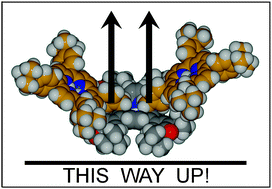
Chem. Commun., 2011,47, 8533-8535
https://doi.org/10.1039/C1CC12396C
Polymorphism and isomerisation of an azobenzene derivative on gold
Modelling explains the polymorphism of functionalized azobenzenes on Au(111) and why two of the four polymorphs are isomerizable with an electrical stimulus.

Chem. Commun., 2011,47, 8662-8663
https://doi.org/10.1039/C1CC12522B
Nanoparticle -coated PDMS elastomers for enhancement of Raman scattering
Au or Ag nanoparticle-coated PDMS elastomers are used for highly sensitive Raman detection and chemical imaging of molecules on solid substrates.
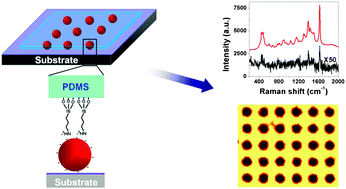
Chem. Commun., 2011,47, 8560-8562
https://doi.org/10.1039/C1CC12027A
Surface-assisted bowl-in-bowl stacking of nonplanar aromatic hydrocarbons
Surface-alignment is an effective way to induce columnar stacking of buckybowls.
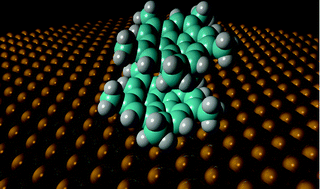
Chem. Commun., 2011,47, 7995-7997
https://doi.org/10.1039/C1CC12540K
Tip- or electron beam-induced surface polymerization
Surface polymerization is initiated locally with the tip of a scanning tunneling microscope or globally with electron beam irradiation.
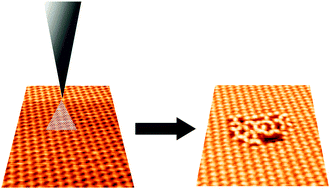
Chem. Commun., 2011,47, 8028-8030
https://doi.org/10.1039/C1CC12065D
Templating an organic array with Si(111)-7×7
Steric hindrance can be used to break the equivalence of di-σ attachment geometries on Si(111)-7x7 and stabilize an ordered array of 1,3,5-methyl benzene molecules.
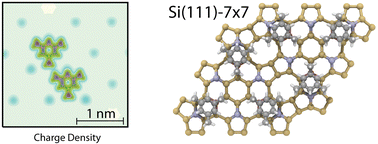
Chem. Commun., 2011,47, 8031-8033
https://doi.org/10.1039/C1CC12311D
Stamping oriented molecular monolayers using liquid crystal inks
Thermotropic liquid crystal (LC)-based inks are combined with patterned anchoring stamps to deposit organic monolayer films with simultaneous control over positional and molecular orientational order in a single step.
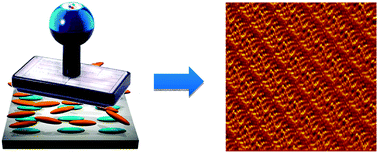
Chem. Commun., 2011,47, 7668-7670
https://doi.org/10.1039/C1CC11462J
Host–guest chemistry at interface for photoswitchable bioelectrocatalysis
Photoswitchable bioelectrocatalysis of glucose with glucose oxidase in an “On–Off” state is fabricated from host–guest chemistry at an interface by using the photocontrolled reversible immobilization and detachment of ferrocene-labeled redox-polymer as mediator.
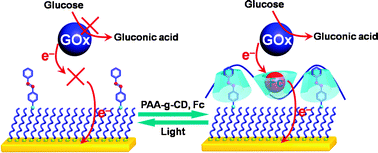
Chem. Commun., 2011,47, 5994-5996
https://doi.org/10.1039/C1CC11289A
About this collection
This web-based themed issue showcases high quality papers in the field of surface chemistry, specifically research carried out on the molecular level. The collated, invited, and peer-reviewed ChemComm articles highlight cutting edge contributions by international leaders in the field.
The guest editors of this web themed issue are Steven De Feyter, Federico Rosei and Dmitrii Perepichka. They are delighted by the overwhelming response that the letter of invitation produced and they express their sincere thanks to the authors. The articles received and published cover a diverse range of contemporary topics in molecule-based surface chemistry.
Articles in this web themed issue will be added to the list below as soon as possible, after they are published. Please return to this page frequently to watch this collection grow.